Gloucestershire
| Gloucestershire | |||
|---|---|---|---|
| County | |||
| |||
|
Motto: Prorsum semper ("Ever forward") | |||
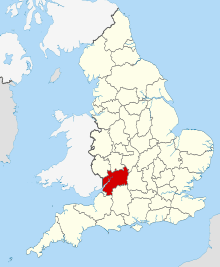 Gloucestershire in England | |||
| Coordinates: 51°50′N 2°10′W / 51.833°N 2.167°WCoordinates: 51°50′N 2°10′W / 51.833°N 2.167°W | |||
| Sovereign state |
| ||
| Country |
| ||
| Region | South West | ||
| Established | Ancient | ||
| Ceremonial county | |||
| Lord Lieutenant | Janet Trotter | ||
| High Sheriff | Charles Martel [1](2018/19) | ||
| Area | 3,150 km2 (1,220 sq mi) | ||
| • Ranked | 16th of 48 | ||
| Population (mid-2017 est.) | 907,200 | ||
| • Ranked | 23rd of 48 | ||
| Density | 287/km2 (740/sq mi) | ||
| Ethnicity | 91.6% White British | ||
| Non-metropolitan county | |||
| County council |
| ||
| Executive | Conservative | ||
| Admin HQ | Gloucester | ||
| Area | 2,653 km2 (1,024 sq mi) | ||
| • Ranked | 13th of 27 | ||
| Population | 628,100 | ||
| • Ranked | 19th of 27 | ||
| Density | 236/km2 (610/sq mi) | ||
| ISO 3166-2 | GB-GLS | ||
| ONS code | 23 | ||
| GSS code | E10000013 | ||
| NUTS | UKK13 | ||
| Website |
www | ||
| Unitary authorities | |||
| Councils | South Gloucestershire Council | ||
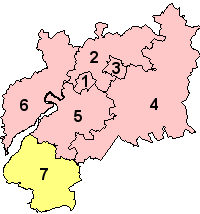 Districts of Gloucestershire Unitary County council area | |||
| Districts | |||
| Members of Parliament | List of MPs | ||
| Police | Gloucestershire Constabulary | ||
| Time zone | Greenwich Mean Time (UTC) | ||
| • Summer (DST) | British Summer Time (UTC+1) | ||
Gloucestershire (/ˈɡlɒstərʃər/ (![]()
![]()
The county town is the city of Gloucester, and other principal towns include Cheltenham, Cirencester, Stroud, Tewkesbury and Dursley.
Gloucestershire borders Herefordshire to the northwest, Wiltshire to the south, Bristol and Somerset to the south west, Worcestershire to the north, Oxfordshire to the east, Warwickshire to the northeast, and the Welsh county of Monmouthshire to the west.
History
Gloucestershire is a historic county mentioned in the Anglo-Saxon Chronicle in the 10th century, though the areas of Winchcombe and the Forest of Dean were not added until the late 11th century. Gloucestershire originally included Bristol, then a small town. The local rural community moved to the port city (as Bristol was to become), and Bristol's population growth accelerated during the industrial revolution. Bristol became a county in its own right, separate from Gloucestershire and Somerset in 1373. It later became part of the administrative County of Avon from 1974 to 1996.
Upon the abolition of Avon in 1996, the region north of Bristol became a unitary authority area of South Gloucestershire and is now part of the ceremonial county of Gloucestershire.
The official former postal county abbreviation was "Glos.", rather than the frequently used but erroneous "Gloucs." or "Glouc.".
In July 2007, Gloucestershire suffered the worst flooding in recorded British history, with tens of thousands of residents affected. The RAF conducted the largest peace time domestic operation in its history to rescue over 120 residents from flood affected areas. The damage was estimated at over £2 billion.[2]
The county recovered rapidly from the disaster, investing in attracting tourists to visit the many sites and diverse range of shops in the area.
Geography and environment
Gloucestershire has three main landscape areas, a large part of the Cotswolds, the Royal Forest of Dean and the Severn Vale. The Cotswolds take up a large portion of the east and south of the county, The Forest of Dean taking up the west, with the Severn and its valley running between these features. The Daffodil Way in the Leadon Valley, on the border of Gloucestershire and Herefordshire surrounding the village of Dymock, is known for its many spring flowers, orchards, and woodland, which attracts many walkers.
Economy
This is a chart of trend of regional gross value added of Gloucestershire at current basic prices published (pp. 240–253) by Office for National Statistics with figures in millions of British Pounds Sterling.
| Year | Regional Gross Value Added[3] | Agriculture[4] | Industry[5] | Services[6] |
|---|---|---|---|---|
| 1995 | 5,771 | 196 | 1,877 | 3,698 |
| 2000 | 8,163 | 148 | 2,677 | 5,338 |
| 2003 | 10,617 | 166 | 2,933 | 7,517 |
The following is a chart of Gloucestershire's gross value added total in thousands of British Pounds Sterling from 1997-2009 based upon the Office for National Statistics figures [7]
| Year | GVA (£ million) |
|---|---|
| 1997 | 7,167 |
| 1998 | 7,630 |
| 1999 | 8,034 |
| 2000 | 8,414 |
| 2001 | 8,947 |
| 2002 | 9,504 |
| 2003 | 10,117 |
| 2004 | 10,525 |
| 2005 | 10,680 |
| 2006 | 11,073 |
| 2007 | 11,563 |
| 2008 | 11,666 |
| 2009 | 11,452 |
The 2009 estimation of £11,452 million GVA can be compared to the South West regional average of £7,927 million.
Education
Secondary schools
Gloucestershire has mainly comprehensive schools with seven selective schools; two are in Stroud (Stroud High School for girls and Marling School for boys), one in Cheltenham (Pate's Grammar) and four in Gloucester (Sir Thomas Rich's and The Crypt for boys and The High School and Ribston Hall for girls). There are 42 state secondary schools, not including sixth form colleges, and 12 independent schools, including the renowned Cheltenham Ladies' College, Cheltenham College and Dean Close School. All but about two schools in each district have a sixth form, but the Forest of Dean only has two schools with sixth forms. All schools in South Gloucestershire have sixth forms.
Higher and further education
Gloucestershire has two universities, the University of Gloucestershire and the Royal Agricultural University, and four higher and further education colleges, Gloucestershire College, Cirencester College, South Gloucestershire and Stroud College and the Royal Forest of Dean College. Each has campuses at multiple locations throughout the county. The University of the West of England also has three locations in Gloucestershire; an associate faculty (Hartpury College) specialising in animal behaviour and welfare, agricultural and sports related courses in Hartpury, Gloucestershire; a regional centre at the Gloucester Docks, Alexandra Warehouse, specialising in Adult and Mental Health Nursing; and Frenchay Campus in South Gloucestershire.
Towns and cities
Gloucestershire has one city and 33 towns:
Cities
Towns
The towns in Gloucestershire are:
- Berkeley
- Cheltenham
- Chipping Campden
- Chipping Sodbury
- Cinderford
- Cirencester
- Coleford
- Dursley
- Fairford
- Kemble
- Lechlade
- Lydney
- Minchinhampton
- Mitcheldean
- Moreton-in-Marsh
- Nailsworth
- Newent
- Northleach
- Painswick
- Quedgeley
- Stonehouse
- Stow-on-the-Wold
- Stroud
- Tetbury
- Tewkesbury
- Thornbury
- Winchcombe
- Wotton-under-Edge
- Yate
Town in Monmouthshire with suburbs in Gloucestershire:
Green belt
The county has two green belt areas, the first covers the southern area in the South Gloucestershire district, to protect outlying villages and towns between Thornbury and Chipping Sodbury from the urban sprawl of the Bristol conurbation. The second belt lies around Gloucester, Cheltenham, and Bishop's Cleeve, to afford those areas and villages in between a protection from urban sprawl and further convergence. Both belts intersect with the boundaries of the Cotswolds AONB.
Antiquities
There are a variety of religious buildings across the county, notably the cathedral of Gloucester, the abbey church of Tewkesbury (which is over 500 years old and has the tallest Norman tower in England), and the church of Cirencester. Of the abbey of Hailes near Winchcombe, founded by Richard, Earl of Cornwall, in 1246, little more than the foundations are left, but these have been excavated and fragments have been brought to light.
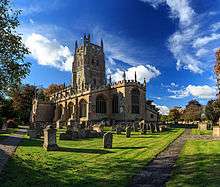
Most of the old market towns have parish churches. At Deerhurst near Tewkesbury and Bishop's Cleeve near Cheltenham, there are churches of special interest on account of the pre-Norman work they retain. There is also a Perpendicular church in Lechlade, and that at Fairford was built (c. 1500), according to tradition, to contain a series of stained-glass windows which are said to have been brought from the Netherlands. These are, however, adjudged to be of English workmanship.
Other notable buildings include Calcot Barn in Calcot, a relic of Kingswood Abbey. Thornbury Castle is a Tudor country house, the pretensions of which evoked the jealousy of Cardinal Wolsey against its builder, Edward Stafford, duke of Buckingham, who was beheaded in 1521. Near Cheltenham is the 15th-century mansion of Southam de la Bere, of timber and stone. Memorials of the de la Bere family appear in the church at Cleeve. The mansion contains a tiled floor from Hailes Abbey. At Great Badminton is the mansion and vast domain of the Beauforts (formerly of the Botelers and others), on the south-eastern boundary of the county. Berkeley Castle at over 800 years old and the ruins of Witcombe Roman Villa at Great Witcombe are also notable heritage features.
There are several royal residences in Gloucestershire, including Highgrove House, Gatcombe Park, and (formerly) Nether Lypiatt Manor.
An annual "cheese-rolling" event takes place at Cooper's Hill, near Brockworth and the Cotswold Games occurred within the county.
Places of interest
| Key | |
| Abbey/Priory/Cathedral | |
| Accessible open space | |
| Amusement/Theme Park | |
| Castle | |
| Country Park | |
| English Heritage | |
| Forestry Commission | |
| Heritage railway | |
| Historic House | |
| Museum (free/not free) | |
| National Trust | |
| Theatre | |
| Zoo | |

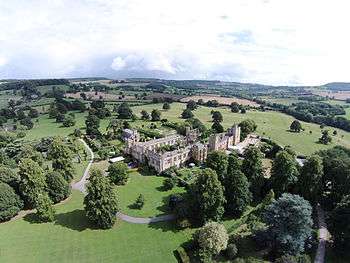
Places of interest in Gloucestershire include:
- Badminton House, residence of the Dukes of Beaufort

- Berkeley Castle, an example of a feudal stronghold.

- Beverston Castle

- Chavenage House

- Cheltenham Town Football Club
- Clearwell Caves
- Dean Forest Railway

- Dyrham Park


- Edward Jenner's House

.svg.png)
- Gloucester Cathedral

- Gloucester Rugby
- Gloucestershire Warwickshire Railway

- Hailes Abbey


- Newark Park


- Owlpen Manor

- Rodborough and Minchinhampton Commons

- Snowshill Manor


- Sudeley Castle, burial place of Queen Catherine Parr, 6th wife and consort of King Henry VIII.

- Stanway House

- River Thames

- Rodmarton Manor

- Severn Bore

- Tewkesbury Abbey

- Tewkesbury Medieval Festival
- Tyndale Monument

- Wildfowl and Wetland Trust, Slimbridge
- Westbury Court Garden
- Woodchester Mansion

Areas of countryside in Gloucestershire include:
Scenic Railway Line:
Media
Gloucestershire's only daily newspaper is the Western Daily Press, while The Citizen, which covers Gloucester, Stroud and the Forest of Dean, and the Gloucestershire Echo, which covers Cheltenham, Tewkesbury and the Cotswolds, were published daily but since October 2017 have been weekly publications. All three, along with free weeklies The Forester, Stroud Life, The Gloucester News and The Cheltenham and Tewkesbury News, are published by Local World. The Stroud News & Journal is a weekly paid-for newspaper based in Stroud. It is published in a tabloid format by Newsquest. Newsquest also produces the weekly Wilts and Gloucestershire Standard newspaper, which covers the southern and eastern parts of the county as well as the weekly Gloucestershire Gazette which covers the south of the county and much of South Gloucestershire.
Gloucester News Centre is an independent news website with news and information for Gloucestershire.
Radio stations in Gloucestershire include BBC Radio Gloucestershire and Heart Gloucestershire, Sunshine Radio and The Breeze (Cheltenham & North Gloucestershire). There are also several community radio stations including Gloucester FM, Radio Winchcombe, Forest of Dean Radio, and North Cotswold Community Radio.
Local TV for the county is provided by BBC West and ITV West Country, although in the northern extremes of Gloucestershire, BBC Midlands and ITV Central (West) covers this area.
In popular culture
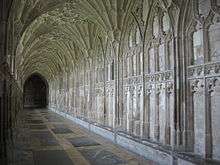
There are two well-known accounts of childhood in rural Gloucestershire in the early 20th century, Laurie Lee's Cider With Rosie and Winifred Foley's A Child in the Forest. Part of Mrs. Craik's novel John Halifax, Gentleman is set in Enderley, a thinly disguised Amberley, where she lived at the time of writing.[8] Most of the book is set in Nortonbury, easily recognisable as Tewkesbury.
The county has also been the setting for a number of high-profile movies and TV series, including Die Another Day, the Harry Potter films and the BBC TV series Butterflies.[9] The film Hot Fuzz was set in Gloucestershire where Simon Pegg, who co-wrote and starred in the film, grew up.
"A Girl's Best Friend", the pilot for the proposed Doctor Who spin-off K-9 and Company, was filmed in Gloucestershire.[10] The setting is the fictional town of Moreton Harwood.[11] The fictional town of Leadworth in Doctor Who is in Gloucestershire.[12] It is the home of companions Amy Pond, Rory Williams and River Song in their childhoods and young adulthoods.[13]
A fictional Brimpsfield was the village, home of Peter and Abby Grant, in the 1970s BBC TV series Survivors, with a railway connection to London.
Animals
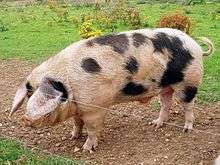
The famous Gloucestershire Old Spots pig is named for Gloucestershire and is historically associated with the county.[14] Sheep roam widely in the Forest of Dean.[15] The Forest of Dean and the Wye Valley also have wild boar.[16]
Gloucester cattle, a rare[17] breed, can still be found in and around Gloucestershire.[18] They can be recognised by the white stripe that runs down the centre of their backs to the tip of their tails. The cattle are famous for producing milk for both Single Gloucester and Double Gloucester cheeses.
See also
- Category:Grade I listed buildings in Gloucestershire
- Custos Rotulorum of Gloucestershire - Keepers of the Rolls
- Diocese of Gloucester
- High Sheriff of Gloucestershire
- Lord Lieutenant of Gloucestershire
- Gloucestershire (UK Parliament constituency) - Historical list of MPs for Gloucestershire constituency
- Gloucestershire County Cricket Club
- Gloucestershire Regiment
- Gloucestershire Constabulary
- Gloucestershire Police and Crime Commissioner
- List of people from Gloucestershire
- List of hills of Gloucestershire
- Royal Gloucestershire Hussars
- West Country dialects
Notes
- ↑ "No. 62229". The London Gazette. 15 March 2018. pp. 4814–4814.
- ↑ "Flood crisis grows as rivers rise". BBC News. 23 July 2007. Retrieved 15 February 2013.
- ↑ Components may not sum to totals due to rounding
- ↑ includes hunting and forestry
- ↑ includes energy and construction
- ↑ includes financial intermediation services indirectly measured
- ↑ http://www.ons.gov.uk/ons/rel/regional-accounts/regional-gross-value-added--income-approach-/december-2011/rft-nuts1.xls
- ↑ "Minchinhampton - Introduction | A History of the County of Gloucester: Volume 11 (pp. 184-190)". British-history.ac.uk. 22 June 2003. Retrieved 15 February 2013.
- ↑ 'Gloucestershire TV and Movie Locations' at Gloucestershire On Screen Archived 22 August 2010 at the Wayback Machine.
- ↑ "Doctor Who Locations Guide: K9 and Company". Doctorwholocations.net. Retrieved 15 February 2013.
- ↑ "K-9 and Company". Doctor Who Reference Guide. Retrieved 29 December 2013.
- ↑ Moffat, Steven (3 April 2010). "The Eleventh Hour". Doctor Who. Series 5. Episode 1. BBC. BBC One.
- ↑ Moffat, Steven (3 April 2010). "The Eleventh Hour". Doctor Who. Series 5. Episode 1. BBC. BBC One.
Moffat, Steven (26 June 2010). "The Big Bang". Doctor Who. Series 5. Episode 13. BBC. BBC One.
Moffat, Steven (27 August 2011). "Let's Kill Hitler". Doctor Who. Series 6. Episode 8. BBC. BBC One. - ↑ "Gloucestershire Old Spots". Rbst.org.uk. Archived from the original on 27 February 2014. Retrieved 23 February 2014.
- ↑ "Campsites in the Forest of Dean". Camping in the forest. Retrieved 23 February 2014.
- ↑ Vidal, John (5 April 2013). "Hundreds of wild boars face cull in Forest of Dean". The Guardian. London. Retrieved 23 February 2014.
- ↑ "Gloucester" (PDF). Rare Breeds Survival Trust. 2011. Archived from the original (PDF) on 27 February 2014. Retrieved 23 February 2014.
- ↑ "Gloucester Cattle Society". gloucestercattle.org.uk.
Further reading
Rudder, Samuel. (1779) A New History of Gloucestershire. Reprint: Nonsuch Publishing, 2006. ISBN 1-84588-023-4 (Free download of original here: A New History of Gloucestershire)
External links


- Gloucestershire County Council Local government web site
- Gloucestershire at Curlie (based on DMOZ)
- Images of Gloucestershire at the English Heritage Archive
